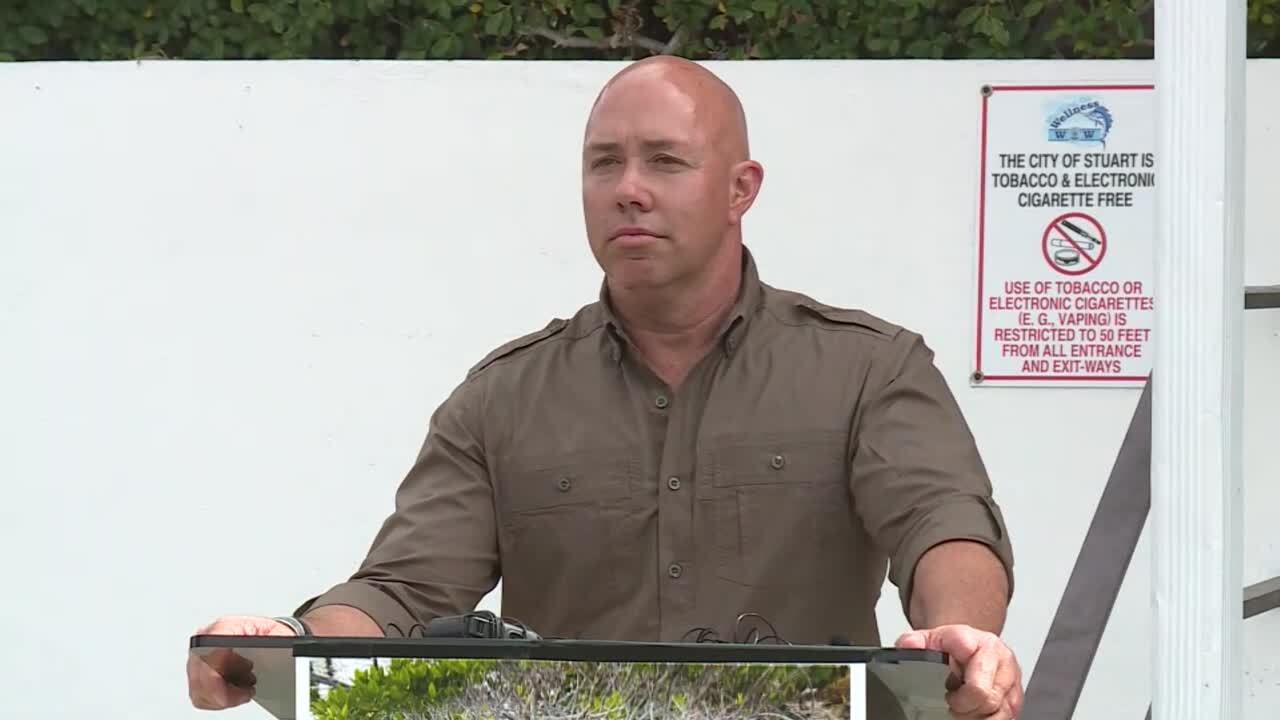STUART, Fla. — A Florida congressman continues to call on the U.S. Army Corps of Engineers to halt discharges from Lake Okeechobee.
"There is no bigger polluter of our community than the United States government," U.S. Rep. Brian Mast, R-Fla., said during a news conference in Stuart on Thursday. "The Corps of Engineers is the biggest polluter of the Indian River Lagoon, the St. Lucie Estuary, the Treasure Coast. Our government. We pay their salaries with our tax dollars."

Mast has repeatedly urged Army Corps Col. James Booth to stop the freshwater releases from the lake into the St. Lucie Estuary.
The Army Corps in February began discharging up to one billion gallons of water into estuaries to get lake levels down and prevent flooding.
As of Tuesday, the lake was down about a foot from where it was last month to 15.39 feet.
The Army Corps announced last week that water released would pause for two weeks starting Friday ahead of the oyster spawning season.
But Mast called the two-week halt insufficient and believes a long-term halt is the only way to prevent the spread of blue-green algae.
"You create the situation of what will become toxic because of what you have turned this estuary into. A freshwater estuary instead of a salt and brackish estuary," Mast said Thursday. "You destroy the ecosystem for seagrass, for dolphin, for sea turtles, for take your pick."
Booth told WPTV anchor Michael Williams on Tuesday that after the two-week pause, he anticipated the resuming discharges to be much lower releases.
"Because we've seen nearly a foot come off the lake," Booth said.

An abnormally wet winter has already helped to foster an algae bloom on Lake Okeechobee, fueling fears that the problem will worsen ahead of hotter weather and the rainy season.
The Florida Department of Environmental Protection identified Wednesday at least five areas with visible blue-green algae in Martin County, including Charlie Leighton Park, which they are now testing for toxins.
In response to WPTV's questions, the Army Corps of Engineers sent the following response, reading in full:
"Water levels must continue to come down before the beginning of both the wet season and the Atlantic hurricane season, for both the ecology of the Lake and the safety of the citizens in the communities around the lake. Lower lake water levels provide flood risk management as well as decrease the probability of large releases occurring during the summer, which is also the peak of algal bloom season. High Lake stages are also linked to increased bloom activity within the Lake.
Through Friday, USACE water managers will continue targeting the maximum allowable flows under the Lake Okeechobee Regulation Schedule 2008 (LORS08) maximum practicable releases south, an average of 4,000 cubic feet per second (cfs) at Julian Keen Jr. Lock and Dam (S-77) to the west, 1,800 cfs at St. Lucie Lock and Dam (S-80) to the east, and up to 500 cfs to the Lake Worth Lagoon through the C-51 canal to the southeast.
To protect salinity within the estuaries, as we said we would, we will be implementing a two-week long rest period after the 29th before we commence any further releases to ready the lake for the oncoming wet and hurricane seasons. Unless conditions significantly change, flows after the rest period will be less than 4,000 west and 1,800 east.
We understand the current lake releases are stressful for the St. Lucie and Caloosahatchee River estuaries and adjacent communities. We know from our consistent engagement with stakeholders that water quality remains one of their significant concerns. As such, it is also one of the principal considerations integrated into our decision-making as we strive to balance the multiple project purposes for Lake Okeechobee water management.
We have multiple projects in planning, design and construction that will help provide relief to the estuaries and send water south. As projects complete construction and we begin to operate them we will begin to have more flexibility to move water where it is needed for restoration and reduce the need for damaging discharges. Restoration efforts depend on improving the storage, treatment, and conveyance of water.
This year alone, we anticipate awarding $3.1 Billion in new construction contracts to keep Everglades restoration projects moving forward and to ensure they are operational as soon as possible, providing additional water storage and increased water flows where needed for restoration, and reduce damaging flows to the Caloosahatchee River and St. Lucie estuaries. We are consistently working with our partners in the State of Florida to invest in long-term solutions with ecosystem restoration projects that are underway to restore the Everglades and limit damaging releases into the Caloosahatchee and St. Lucie estuaries and move water south to the central Everglades and Florida Bay.
The Assistant Secretary of the Army for Civil Works and the Department of Commerce, Undersecretary for Oceans and Atmosphere met in mid-December and again in January. They discussed the need to find resolution on the environmental baseline used to analyze the effects of LOSOM in the Biological Opinion. While we do not have a definitive timeframe to resolution, the Jacksonville District is continuing to manage Lake Okeechobee levels under its current plan, using that plan’s existing flexibilities, in a LOSOM-like manner. While we can’t provide a definitive timeframe on the execution of the LOSOM Record of Decision (ROD), we will keep everyone informed as discussions continue."







